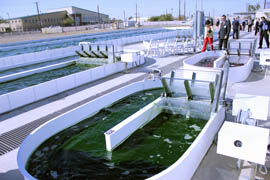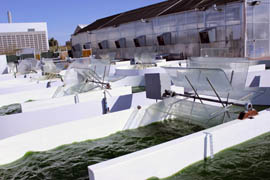Cronkite News has moved to a new home at cronkitenews.azpbs.org. Use this site to search archives from 2011 to May 2015. You can search the new site for current stories.
Officials: Expansion of algae-production facility positions Arizona as leader
MESA – A five–fold expansion of the algae lab at Arizona State University’s Polytechnic campus will help move Arizona to the forefront of algae–based research and production, Gov. Jan Brewer said Tuesday.
“It’s wonderful to see this center begin to blossom – allowing Arizona the potential to be a national and global leader in algae research and biotechnology, reducing America’s dependence on fossil fuel, increasing prospects for green jobs and profits, cleaning air and water and creating valuable products for human and animal use,” Brewer said.
The governor and other public officials, researchers and ASU personnel dedicated an expansion that adds 80,000 gallons of capacity to the test beds at the Arizona Center for Algae Technology and Innovation.
Proponents say Arizona is uniquely positioned to be a leader in the research and development of algae-based products because of its abundant sunlight, available water and flat farmland.
“That makes it particularly attractive to Arizona because we have something that not everyone can copy,” said Mitzi Montoya, vice provost and dean for ASU’s College of Technology and Innovation. “That’s actually the beauty of this.”
Most of the new space will be used to grow algae for other companies to use in their research, said Tom Dempster, the facility’s lab manager and a research professor.
Much of what the center does and will do in the future is provide materials and space for partners to work, Dempster said.
Those n partners, such as Vally–based algae research company Heliae, often cannot produce enough algae to supply their own machines at capacity.
“The overall goal of this facility is to advance the biofuels industry,” Dempster said. “The ultimate goal here is to reduce our country’s dependency on foreign fuels.”
Montoya said researchers are hopeful that algae–based fuel will become more prevalent in the next 10 years.
“This is another natural and renewable source that can be moved to scale,” she said.
Dempster said the center’s new production potential should increase the quantity and speed of algae grown, collaboration between research organizations and availability of biomass for research.
“We’re providing a platform for share of ideas and information, that really, previously, hasn’t existed, and certainly not to this magnitude,” he said.









